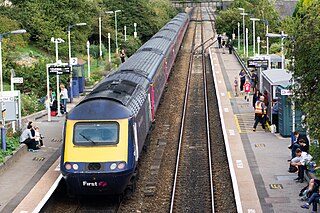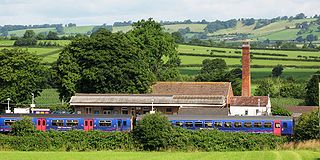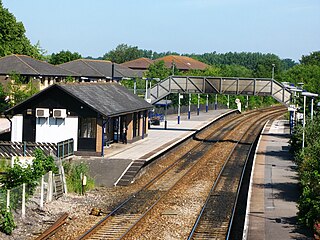
Westbury is a market town and civil parish in west Wiltshire,England. The town lies below the northwestern edge of Salisbury Plain,about 4 miles (6 km) south of Trowbridge and a similar distance north of Warminster.

Dilton Marsh is a village and civil parish in the far west of the county of Wiltshire,in the southwest of England. The village is about 1.5 miles (2.4 km) southwest of the centre of the town of Westbury;Dilton Marsh remains a distinct settlement with its own character and community,bounded and separated from Westbury Leigh by the Biss Brook.

The Wessex Main Line is the railway line from Bristol Temple Meads to Southampton Central. Diverging from this route is the Heart of Wessex Line from Westbury to Weymouth. The Wessex Main Line intersects the Reading to Taunton Line at Westbury and the West of England Main Line at Salisbury.

Portsmouth Harbour railway station serves the city of Portsmouth,in Hampshire,England. It is situated in Portsmouth Harbour,between the Gunwharf Quays shopping centre and the Historic Dockyard. It is an important transport terminal,with a bus interchange and ferry services to Gosport and the Isle of Wight. Unusually for a main line railway station,it is built over water as the station was originally constructed on wooden piles,which were later replaced by iron supports.

Oldfield Park railway station is on the Great Western Main Line in South West England,serving the mainly residential areas of southern Bath,Somerset. It is 107 miles 72 chains (173.6 km) down the line from London Paddington and is situated between Bath Spa and Keynsham.

Salisbury railway station serves the cathedral city of Salisbury in Wiltshire,England. It is 83 miles 43 chains (134.4 km) from London Waterloo on the West of England line to Exeter St Davids. This is crossed by the Wessex Main Line from Bristol Temple Meads to Southampton Central. The station is operated and served by South Western Railway (SWR),and is also served by Great Western Railway (GWR).

Filton Abbey Wood railway station serves the town of Filton in South Gloucestershire,England;it is located 4.4 miles (7.1 km) from Bristol Temple Meads. There are four platforms but minimal facilities. The station is managed by Great Western Railway,which also operates all calling services. The general service level is nine trains per hour:two to Cardiff Central,two towards Gloucester,one towards Taunton,two towards Westbury and two to Bristol Temple Meads.

Castle Cary railway station is on the Reading to Taunton line 115.25 miles (185.48 km) south west of London Paddington and the Bristol to Weymouth line 47.75 miles (77 km) south of Bristol Temple Meads. The two routes share tracks between Westbury and Castle Cary stations and are both operated by Great Western Railway,which also manages the station. The station is 1 mile (1.6 km) north of the market town of Castle Cary and 5 miles (8 km) south of Shepton Mallet in a largely rural area of Somerset,England.

Westbury railway station serves the market town of Westbury in Wiltshire,England. The station is managed by Great Western Railway.

Southampton Central is a main line railway station serving the city of Southampton in Hampshire,southern England. It is on the South West Main Line and also serves the Wessex Main Line and the West Coastway Line. The station is approached from the London direction by passing through Southampton Tunnel and is 79 miles 19 chains (127.5 km) measured from London Waterloo. It is the busiest station in Hampshire and the fifth busiest in South East England.

Bruton railway station serves a largely rural area in the county of Somerset in England. The station is situated in the market town of Bruton. The station is on the Bristol to Weymouth line some 32.75 miles (53 km) south of Bath Spa. Trains on the Reading to Taunton line pass through the station but do not normally stop. Services are operated by Great Western Railway and South Western Railway.

Patchway railway station is on the South Wales Main Line,serving the town of Patchway and village of Stoke Gifford in South Gloucestershire,England. It is 6 miles (10 km) from Bristol Temple Meads. Its three letter station code is PWY. It is managed by Great Western Railway,who provide all train services at the station;there is generally a train every hour in each direction between Cardiff Central and Taunton.

Chippenham railway station is on the Great Western Main Line (GWML) in South West England,serving the town of Chippenham,Wiltshire. It is 93 miles 76 chains down the line from the zero point at London Paddington and is situated between Swindon and Bath Spa on the GWML. The Wessex Main Line diverges from the GWML to the southwest of Chippenham and runs to Trowbridge via Melksham.

Trowbridge railway station serves the county town of Trowbridge in Wiltshire,England. The station is 24 miles (39 km) south east of Bristol Temple Meads on the Wessex Main Line and is managed by Great Western Railway.

Warminster railway station serves the historic market town of Warminster in Wiltshire,England.

Avonmouth railway station is located on the Severn Beach Line and serves the district of Avonmouth in Bristol,England. It is 9.0 miles (14.5 km) from Bristol Temple Meads. Its three letter station code is AVN. The station has two platforms,on either side of two running lines. As of 2015 it is managed by Great Western Railway,which is the third franchise to be responsible for the station since privatisation in 1997. They provide all train services at the station,mainly a train every 30 minutes to Bristol Temple Meads and one every hour to Severn Beach.

Melksham railway station serves the town of Melksham in Wiltshire,England. It is 100 miles 13 chains measured from London Paddington,on the TransWilts Line between Chippenham and Trowbridge that was originally part of the Wilts,Somerset and Weymouth Railway,absorbed in 1850 by the Great Western Railway.
The Wilts,Somerset and Weymouth Railway (WS&WR) was an early railway company in south-western England. It obtained Parliamentary powers in 1845 to build a railway from near Chippenham in Wiltshire,southward to Salisbury and Weymouth in Dorset. It opened the first part of the network but found it impossible to raise further money and sold its line to the Great Western Railway (GWR) in 1850.
The Salisbury branch line of the Great Western Railway from Westbury to Salisbury in Wiltshire,England,was completed in 1856. Most of the smaller stations were closed in 1955 but the line remains in use as part of the Wessex Main Line.

Lacock Halt was a minor railway station on the Chippenham–Trowbridge section of the former Wilts,Somerset and Weymouth Railway (WSWR),which opened as far as Westbury on 2 September 1848. This connected to the Great Western Main Line at Thingley Junction and was incorporated into the Great Western Railway in March 1850 after the WSWR ran into financial difficulties.



















